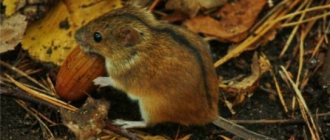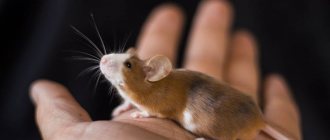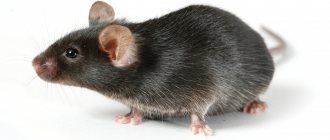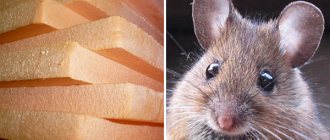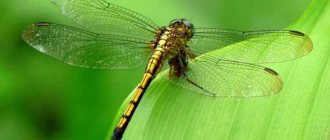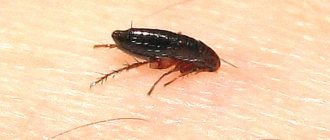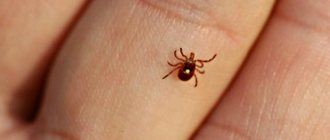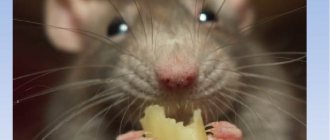General characteristics of mice
These are the smallest representatives of the rodent genus. They are capable of growing up to 15 – 20 cm in height and weighing about 30 – 60 grams. They come in different colors, but only gray, white or brown. There are up to 50 shades of rodent fur. By the age of 6–8 weeks, the female becomes capable of childbearing. Capable of giving birth to 5 to 10 mice at a time.
For copulation, the female and male should be kept apart until the very moment of copulation. The lifespan of mice is 2 – 3 years. They are primarily herbivores, but are essentially omnivores. A small mouse sometimes eats meat, the corpses of relatives, and is capable of gnawing the tail of its neighbor out of hunger. Unlike guinea pigs, mice do not need fortified food at home.
What to feed a decorative mouse
The life of decorative mice at home is much simpler than that of their wild counterparts. An owner interested in a long and healthy life of an ornamental rodent must provide it with adequate and nutritious food in sufficient quantities. And a truly caring owner is also ready to personally compose food for his pet from the most useful ingredients.
Hard food
For ornamental mice, the basis of the diet is grain food, composed of a mixture of seeds of woody and/or herbaceous plants. You can select from the following components:
- Oats . Oat seeds contain more than 40% starch, about 14% protein and 4-5% fat, as well as B vitamins. Cereals that are in the stage of milky ripeness are especially useful for domestic rodents.
- Wheat . Rich in starch (at least 65%) and protein (up to 15%), not too fatty (only 2%), but contains mineral salts and vitamins PP, B-group. For normal metabolism, domestic mice should be given sprouted or soaked grains, not dry ones.
- Sunflower seeds for rodents are a very important component of the diet, healthy and highly nutritious (about 52% fat and up to 32% vegetable oil). It contains fatty acids and minerals in significant quantities, so the percentage of seeds in the feed mixture should not exceed 15%. With increasing dosage, pets may develop obesity.
- Millet . Red varieties of millet are considered the most useful and nutritious for ornamental mice. These seeds of cereal herbaceous plants are saturated with proteins, so their amount in the diet should be increased to 60-70%. Millet is given either in a mixture of dried seeds, or in its raw form - in panicles of milky-waxy ripeness.
- Legumes (soybeans, beans) are recommended to be given to mice in boiled form, peas - in the form of boiled cereal. These seeds are also quite nutritious; their abundant consumption leads to obesity.
In addition to cultivated plants, mice should be given seeds of wild plants, tubers, berries, roots, and nuts.
If the owner of decorative rodents does not want to prepare food mixtures on their own, you can buy specialized food in the store. The basis of such products are approximately the same components - oats, millet, wheat. They have a balanced composition of microelements, plant and animal proteins, fats and vitamins.
It is important to remember that you cannot feed mice exclusively with industrial mixtures; you must add natural ingredients - vegetables, fruits, berries, grass.
Juicy food
Juicy food - vegetables, root vegetables, melons, fruits and berries. For feeding rodents choose:
- Cabbage (except red cabbage). Savoy cabbage, white cabbage, cauliflower, broccoli are rich in vitamin C, amino acids and microelements necessary for the normal metabolism and life of mice.
- Rutabaga . Rutabaga contains a lot of glucose, 1-2% protein and fiber, 0.2% fat and a rich set of vitamins (C, P, B) with minerals (potassium, calcium, iron, phosphorus, magnesium and sulfur).
- Carrot . Carrots contain about 2.5% proteins and 12% sugars, making this root vegetable palatable. The product is useful for mice due to its saturation with vitamins and microelements; its regular use normalizes metabolic processes and has a positive effect on the condition of the sensory organs, skin and fur.
- Cucumbers . Low-calorie and not very nutritious cucumbers compensate for the mouse body's need for water, and also contribute to better absorption of nutritional components from grain feed.
- Apples . Can be given fresh or dried. The latter are best soaked for a couple of hours and boiled a little. Apples contain fructose, fiber and pectin, and are rich in beneficial microelements and vitamins. Pets are allowed to be given fruit without any signs of damage, let alone rotting.
- Pears . Pears can also be part of the diet of mice, however, due to the high sugar content, they must be given in limited quantities so as not to disrupt the animals’ metabolism.
- Strawberries (strawberries) . Strawberries and strawberries contain about 15% sugars (fructose and glucose) and 1% acids, pectin, vitamins (A, E, C, B-groups) and trace elements such as iron, phosphorus, cobalt, manganese.
Healthy! Green potato and juicy carrot tops, as well as the top leaves of cabbage, should be periodically added to the rodents' diet.
Among the succulent food that is beneficial for mice, we should also mention turnips, beets, potatoes and zucchini.
Habitat of a small rodent
The distribution range of mice in natural conditions covers most climatic zones, continents and zones. Representatives of the family can be seen in deciduous and coniferous forests, in tropical thickets, in deserts and steppes, in swampy areas or on mountain slopes. But the most comfortable habitat is human dwellings.
Mice often make nests using grass stems, settle in burrows abandoned by other animals, or dig complex communications under the thickness of the earth. Mountain, forest and steppe varieties of rodents, unlike swamp ones, float rather poorly on water.
Nutritional characteristics of mice depending on breed
What do rats eat at home and in the wild?
The diet of rodent species is similar, but there are some nuances in feeding different breeds of mice. Large animals need 7-15 g of food per day, small species need 5-10 g per day.
Japanese dwarf mouse
Japanese mouse
The size of a small decorative rodent does not exceed 4-6 cm. Animals are fed once a day, the amount of food is 1 tsp. The diet of the Japanese mouse is based on grains, vegetables, fruits, and greens. Animals love to chew on banana chips. For proper development of the skeletal system, be sure to add chalk to your food.
Wood mouse
The size of the animal is 7-10 cm. What wood mice like to eat: whole grain cereals, root vegetables, berries, fruits, pumpkin and sunflower seeds, nuts, mushrooms. In the summer, the animal willingly eats grass; in the winter, the animal is given hay.
Little mouse
The miniature animal measures 5-7 cm. The animal is fed 2 times a day, the volume of food should be 1-1.5 tsp. What mice like to eat: cereals, legumes, insects, pumpkin and flax seeds, egg whites.
Harvest mouse
An adult of this species reaches 10-13 cm. The rodent feeds on plant and animal foods. Mice should be given a variety of grains, roots, fruits, greens and regular vegetables. Pieces of chicken fillet, cottage cheese, and eggs are added to the diet. Pieces of bread are dried and given in the form of crackers.
Harvest mouse
Important! All breeds of mice consume at least 25 ml of water per day. The settled liquid should be kept in the drinking bowl around the clock.
Features of behavior
It is interesting to observe the behavior of these rodents. They are smart, active, inquisitive, and capable of playing pranks. In the wild, each animal occupies its own territory. Males require more space. Sometimes they give the females a little space in their area. Males tend to defend their own territory from the encroachments of strangers. Females, if necessary, also rush into battle for a place to live.
Females are more friendly and sociable in captivity. They will not fight if there are several individuals living in a cage. If offspring appear at the same time, they raise them together, helping each other.
Sometimes female mice prefer to place newborn mice separately. Males should not be kept together - just like in the wild, everyone wants to have their own territory. Under natural conditions, they do not help mothers raise their offspring. While in captivity, the male is able to warm the babies with his body while the female rests or eats.
Diet of mice in captivity
What do ferrets eat in the wild and at home - food list
When keeping an animal as a pet, it is necessary to provide the rodent with a balanced diet, which will ensure that the body receives proteins, fats and carbohydrates in sufficient quantities. A diet containing the necessary minerals and vitamins has a beneficial effect on the condition of the animal’s coat, bone tissue, teeth and claws.
What should you feed your mouse at home?
The easiest way is to purchase specialized feed in the store, available in the “economy” and “premium” classes. The basis of cheap feed is a mixture of wheat, oats, and millet. High-quality ready-made food has a balanced composition, contains valuable plant and animal proteins and fats, and essential microelements. Experts do not recommend feeding rodents exclusively with compound feed. They should be combined with natural products. Vegetables, fruits and herbs rich in fiber are especially important.
Ready-made food for rodents
What do mice eat when creating their own diet:
- various cereals, which it is advisable to give whole;
- root vegetables, vegetables, fruits;
- seeds, nuts; legumes;
- egg white, lard, cheese.
In the spring, lacking vitamins, the mouse willingly eats grass and green vegetables. The diet of young animals and pregnant females should contain more calories: proteins and fats necessary for growth and formation of the skeleton and internal organs.
The diet of a rodent is made up taking into account the following factors:
- daily nutrient requirements depending on the species or breed;
- physiological state (illness, pregnancy, postpartum period);
- pet's age;
- time of year (in summer mice feed more actively).
Important! It is unacceptable to feed your pet table scraps. Salt and spices can negatively affect the health of a rodent.
Diet of mice in the wild
Remembering children's cartoons, many are sure that more than anything else, all mice love cheese. This is not entirely true, and in the wild their diet is completely different than in captivity. In their stashes it is possible to find such agricultural crops as wheat, rye, oats, grain, corn, barley, oats, sorghum, millet, and the fruits of various plants. Small mice feed on them in large quantities, causing irreparable damage to agriculture.
Since they reproduce quickly (each female gives birth 4 times a year), rodent control is quite difficult. Voles, steppe and meadow inhabitants happily feed on seeds of deciduous trees, nuts, mushrooms, and tops. If the reserves made in the autumn and spring are not enough to last the whole winter, mice find plant roots, nuts, mushrooms, and so on underground. In winter, without hibernating and being in a panic from lack of food, the mouse often even eats beetles, spiders, and worms.
What to feed a mouse at home
At home, mice should eat a balanced diet, including not only carbohydrates, but also vegetables and fruits. The list of basic diets includes wheat, barley, corn, oats, rye, millet, and sorghum. Wheat is considered the best food. It is rich in carbohydrates, proteins, vitamins and calcium. It is better to alternate different types of grains in your diet. They must be solid. The amount of food for one individual per day is approximately 1 tsp. Peas are considered a high protein food. It is given 2 times a week.
You can diversify your pet's diet with special food for mice and sweets. Decorative mice love all types of nuts, sunflower seeds, pumpkin seeds, and caraway seeds. Their norm is 1 nut or 2–4 seeds per day. There must be a drinking bowl with water in the cage. When choosing food, you need to give preference to ingredients with sufficient protein and fiber content. Sometimes you can give egg whites and bread.
Important! In front of each jaw, the mouse constantly grows 2 sharp teeth. The animal is forced to constantly grind them down, so they are very sharp.
The diet must include vegetables and fruits: cucumber, apple, zucchini, cauliflower, lettuce, broccoli, banana, quince, parsley, pear, plum. Vegetables are given every other day, and fruits 2-3 times a week. Since mice love to chew and thus wear down their teeth, it is necessary to provide them with food suitable for this operation: carrots, apples, nuts, twigs of apple trees, rowan trees and conifers. According to observations, rodents love cookies and chocolate.
Pets should be pampered with such food occasionally in limited quantities. Foods high in sugar and fat can cause obesity and dental problems in your pet. Hard cheese is not included in the diet of mice, although rodent pests can eat everything indiscriminately. Also, decorative mice should not be given citrus fruits, meat, smoked meats, food for cats and dogs, tomatoes, cabbage, potatoes, onions, rhubarb, and milk.
Did you know? There are
“dancing mice” (Japanese) that constantly spin in place and move tortuously due to disruption of the pituitary gland. And “singing mice” make sounds like a cricket.
What do rodents eat in captivity?
Living near humans, rodents eat any food. Most often these are fruits and vegetables, hard cheeses, milk, sugar, sausage, dried fish, bread. Among vegetables, the mouse willingly eats raw potatoes, carrots, and beets. House mice give birth to offspring up to 6 times a year. The litter contains about 10 mice, which by the age of 2 months are fully mature individuals. When rodents are hungry, they even feed on wood and paper, crushing them with their strong teeth.
If a mouse is kept in the house as a pet, it eats not only human food, but also the imported food offered to it. Such food does not contain husks or coarse grasses. They include nuts and seeds in a small percentage. Owners can provide their pets with a natural diet through seeds, cereals, protein products, vegetables and fruits, herbs, bread and cheese.
What to feed rodents? A detailed guide to feeding rats, mice, hamsters and guinea pigs
Domestic rodents include rats and mice, guinea pigs and hamsters, degus, squirrels and chinchillas, and much more exotic animals: for example, capybaras. Rabbits and ferrets are sometimes classified as rodents, although this is incorrect. Rabbits are lagomorphs, and ferrets are predators from the mustelidae family that have nothing to do with rodents.
Each rodent has its own characteristics and needs. Everyone requires a special diet that would provide them with all the necessary microelements, nutrients and vitamins.
We will briefly talk about the most popular pet rodents, food for rodents, needs and a competent menu for every day.
Rats
Rats are omnivorous and unpretentious by nature. They eat almost everything with great pleasure, so the owner must carefully monitor the diet of his pet.
The rat should be fed twice a day - morning and evening, preferably at the same time; rat pups, pregnant and lactating females can be fed three or four times. Every day a healthy adult rat consumes about 80% of its body weight.
What to feed a rat:
- The basis of the diet is cereals. Cereals can be bought ready-made at a pet store, you can cook unsalted porridge without oil, cook pasta, give boiled corn and bread. Buckwheat, millet, barley, and wheat are especially useful for animals.
- Fresh vegetables, fruits and herbs - also daily. This is not only cabbage and carrots, but also tomatoes, pumpkin, cucumbers, apples, bananas, plums, dates, berries - cranberries, blueberries, strawberries, raspberries.
- Additional vitamin treats in the form of “lollipops”, “candies”, “sticks”. All this is sold in pet stores.
- Protein in the form of unsalted meat, cottage cheese, yogurt, cheese, seafood . Rats do not need a lot of protein, in fact, protein diets for rats are harmful and can lead to premature aging. Protein treats can be fed to your pet every few days.
- Rats are very fond of seeds, especially weedy herbs - for example, dandelions; sometimes you can feed your pet sunflower or pumpkin seeds. Treat your rat to meadow herbs: plantain, chicory, shepherd's purse, dandelion, parsley and dill.
What not to feed your rat: chocolate and other confectionery products, smoked sausage, salty and moldy cheeses. You should not give your pet red cabbage, Brussels sprouts, artichokes, legumes, or licorice. Be careful with herbs - mistletoe, tomato leaves, lilies of the valley, tulips, azalea, fern, ivy and begonia are deadly poisonous to rats.
Mice
Like rats, mice are omnivores with a bias towards herbivory. The easiest way is to buy industrial food for your pet at a pet store - the ingredients there are balanced, they provide the pet with all the necessary nutrients, vitamins and minerals.
Mice need to be fed twice a day, preferably at the same time. Mice, pregnant and lactating females - 3-4 times a day.
What to feed mice:
- Grain mixtures - oilseed grains, legumes, walnuts, almonds, peas, soybeans, beans, lentils, oatmeal, bran, bread or wholemeal flour. Mice readily eat hay, and in winter they need to be given sprouted oats.
- Juicy food - fruits, vegetables and greens, which include green salad, spinach, corn, pumpkin, bananas, parsley, potatoes, cabbage, sorrel, cucumbers, carrots, apples, green peas, celery.
- Proteins - cottage cheese, milk (pasteurized and boiled, not sour), you can give pieces of unsalted lard, egg whites.
- Just like rats, mice need to buy extra vitamin treats . The mouse grinds down its growing teeth on them.
What not to feed your mouse: onions, chocolate and garlic, which contain toxic theobromine, peanuts, citrus fruits, poisonous herbs.
Guinea pigs
Guinea pigs are fed two to three times a day, pregnant and lactating females three to four times. It is advisable to feed at the same time so that the animal develops a certain diet. On average, a healthy adult pig eats about 8% of its weight, that is, approximately 80 g for a kilogram. This is one or two spoons of dry specialized food per feeding.
Unlike rats and mice, pigs are herbivores, and the basis of their diet is hay. Hay should be kept in the cage at all times: the pet receives useful substances from it, and constant chewing helps to wear down the teeth.
What to feed your guinea pig:
- Hay - as mentioned above, hay should be in the cage at all times.
- Grain mixtures consisting of wheat, oats, barley, lentils, millet, sunflower seeds, corn, peanuts, peas. Pet stores sell ready-made food mixtures for guinea pigs.
- Fresh vegetables and fruits - cucumbers, carrots, tomatoes, cabbage, broccoli, pumpkin, bell peppers, beets, rutabaga, Jerusalem artichoke, sweet corn, apples, pears, bananas, tangerines and oranges, seedless grapes, melon, watermelon, strawberries.
- Fresh herbs - dandelion, dried nettle, spinach, dill and celery, alfalfa, clover, yarrow, plantain, dandelion.
It is useful to give pigs something to wear down their teeth - for example, branches of alder, apple and pear trees, willow, birch. Solid vitamins for grinding teeth can also be bought at a pet store, along with a salt stone that hangs inside the cage. From it the animal receives the necessary salt. Table salt should not be given to pigs!
What not to feed a guinea pig: onions, radishes, rhubarb, apricot, peach and cherry, all kinds of animal products - the pig does not need or benefit from them, all indoor decorative flowers, some types of herbs - St. John's wort, datura, night blindness, belladonna, celandine , lily of the valley, poppy, henbane, buttercups, etc. You should not give your pigs salted, smoked, fried foods, white bread, confectionery, chocolate.
Hamsters
Hamsters are fed twice a day, morning and evening; pregnant and lactating females, as well as hamsters, are fed a little more often. Some hamster breeders recommend feeding their pets once, some are inclined to feed them twice a day, but the evening portion should be larger than the morning portion, because hamsters are nocturnal animals.
In general, the diet of hamsters is similar to the diet of rats and mice.
What to feed your hamster:
- Cereals and nuts - ready-made mixtures for hamsters, wheat, buckwheat, oats, legumes, barley, all kinds of nuts, except almonds, melon, pumpkin and sunflower seeds.
- Fruits and vegetables - apples, pear, banana, apricot, melon, peach, seedless grapes and raisins, pumpkin, carrots, tomatoes, eggplant, corn, green beans, Chinese cabbage, broccoli, chickpeas, celery, Jerusalem artichoke, semi-finished vegetable mixtures, squash, turnips, beets, strawberries, blueberries, gooseberries, currants. You can give dried fruits - banana chips, dried apricots, dried apples.
- Greens and tree leaves - clover, dandelion and plantain, parsley and dill, leaves of willow, beech, ash, cherry, pear, apple, maple, poplar, walnut.
- Animal proteins - your hamster should be given them occasionally, about 2-3 per week, and not much: boiled chicken, chicken or quail eggs, cottage cheese and yogurt, boiled fish and shrimp, worms, butterflies, and grasshoppers bought at pet stores.
As treats, you can give your hamster rose petals and unsalted popcorn without butter.
What not to feed a hamster: hamsters should not be given cheese, ready-made food for other animals, white and brown bread, potatoes, milk, garlic and onions, sausage, fried and fatty foods, confectionery and chocolate, poisonous plants, mushrooms, citrus fruits , mint, sorrel, cabbage. Meadow grasses cannot be collected near roadsides and generally within the city. You should not give hamsters insects caught in the wild.
The easiest way is to feed rodents with ready-made mixtures, which are sold in pet stores, plus give fresh herbs, vegetables and fruits in small quantities every day.
Vitamin supplements will be useful, especially important for young and elderly pets, pregnant and lactating females. Sometimes you can pamper your pets: give them special cookies, candies and treats that will not only please him, but also have a positive effect on his health. Related Products:
Feeding decorative pet rodents
Inexperienced owners of ornamental animals have the most common question about what mice eat, and whether they can be fed with scraps from the human table.
Compared to their free-living counterparts, the rhythm and living conditions of pets are noticeably different. Therefore, you cannot give the animal everything and expect it to be healthy. Food should be varied, balanced, contain the required amount of vitamins, microelements and not harm the animal’s body. This takes into account:
- age of the rodent;
- his weight;
- view;
- health status.
Full advice regarding the nutrition of a particular animal can be obtained from a veterinarian or breeder.
Ready-made feed
Buying special mixtures is convenient and profitable. Moreover, they contain everything that mice love to eat. Among the variety of foods offered in pet stores, it is difficult to choose the right one.
Feed
You need to know that they are divided into categories:
- Super premium class. The highest quality product with a predominant content of wheat and animal proteins with low fat content.
- Premium class. Less expensive food. It may not contain any components necessary for a rodent, but this is easily compensated for by feeding, which should be given once a week.
- Economy class. The cheapest option, consisting mainly of not the most healthy grain crops.
When choosing food, you need to pay attention to the manufacturer (foreign manufacturers are considered the best) and the composition of the mixture. A combination of several types of grain, meat and vegetable additives would be ideal. The presence of food coloring is contraindicated. The packaging must be sealed from polyethylene or foil so that insects cannot get inside.
The female feeds newborn babies with milk. They do not require additional food until they are 3 weeks old. Then the granules are soaked in water in small quantities and placed in a cage, thereby teaching the mice to eat solid food. At the age of one month, they already switch to food for adults.
Natural diet
If for some reason you decide to keep your animal on natural products, then first of all you need to stock up on cereal grains. In the mixture, preference is given to wheat, adding oats, barley, rye, and millet.
By type of nutrition, the mouse is an omnivorous mammal, so animal proteins should be given once a week. For example, a piece of egg, boiled lean meat without salt and spices, fish. At the pet store you can buy dried freshwater crustaceans, which rodents love.
Peanuts, sunflower seeds, and walnuts are given with great caution. These are fatty foods that are bad for the health of mice. Their daily intake should be strictly limited.
Vegetables, fruits, and berries are given fresh or dried 2-3 times a week in small portions.
Brown bread crackers are offered to pets no more than 1–2 times a month, 1 piece at a time.
It is useful for the teeth to give the animals branches of coniferous trees, rowan, apple, and pear.
Occasionally, pets are fed low-fat cottage cheese; this is a good source of calcium.
Prohibited Products
Mice should absolutely not eat:
- Everything that was fried was smoked and salted.
- Sweets. These include sweets, chocolate, ice cream, cookies, pies, and cakes.
- Any spices, as well as onions and garlic.
- Citrus and exotic fruits.
- Tomatoes.
- Poisonous herbs.
Sometimes an animal may have an individual intolerance to a certain product, then the diet is adjusted.
